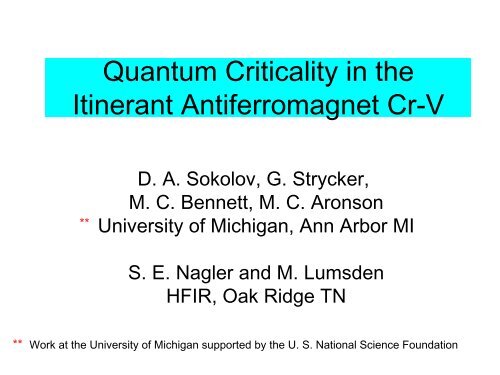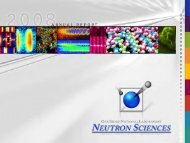Quantum Criticality in the Itinerant Antiferromagnet Cr-V
Quantum Criticality in the Itinerant Antiferromagnet Cr-V
Quantum Criticality in the Itinerant Antiferromagnet Cr-V
Create successful ePaper yourself
Turn your PDF publications into a flip-book with our unique Google optimized e-Paper software.
<strong>Quantum</strong> <strong><strong>Cr</strong>iticality</strong> <strong>in</strong> <strong>the</strong><br />
It<strong>in</strong>erant <strong>Antiferromagnet</strong> <strong>Cr</strong>-V<br />
**<br />
D. A. Sokolov, G. Strycker,<br />
M. C. Bennett, M. C. Aronson<br />
University of Michigan, Ann Arbor MI<br />
S. E. Nagler and M. Lumsden<br />
HFIR, Oak Ridge TN<br />
** Work at <strong>the</strong> University of Michigan supported by <strong>the</strong> U. S. National Science Foundation
Heavy Fermion Intermetallics<br />
CePd 2 Si 2 (Mathur 1998)<br />
<strong>Quantum</strong> <strong>Cr</strong>itical Po<strong>in</strong>ts<br />
Complex Oxides<br />
Need for simpler model systems: it<strong>in</strong>erant magnets
T>T N<br />
T
<strong>Quantum</strong> critical po<strong>in</strong>t <strong>in</strong> <strong>Cr</strong> 1-x V x (x=x C =0.035)<br />
x x C : simultaneous suppression of T N and staggered moment μ<br />
<strong>Cr</strong>: [Ar]3d 5 4s 1<br />
V: [Ar]3d 3 4s 2<br />
Fawcett 1994<br />
x C ~0.038<br />
Koehler 1966
Electron Microprobe<br />
45 g s<strong>in</strong>gle crystal grown by arc-zone melt<strong>in</strong>g (Ames Laboratory)<br />
1. rectangular slab<br />
spark-cut from<br />
<strong>in</strong>terior of crystal<br />
top view of slab<br />
after polish<strong>in</strong>g<br />
2. Surface damaged by<br />
spark cutt<strong>in</strong>g, removed by<br />
polish<strong>in</strong>g.<br />
Composition of crystal <strong>in</strong>terior is nom<strong>in</strong>al 3.5 +/- 0.2 at. % V.<br />
3. Microprobe performed on<br />
<strong>in</strong>dicated area.<br />
at. %V
Electrical Resistivity of <strong>Cr</strong> 0.965 V 0.035<br />
Takeuchi 1980<br />
V concentration 3.5%
Elastic Scatter<strong>in</strong>g: Magnetic Modulation<br />
Triple axis spectroscopy: HB-3 at High Flux Isotope Reactor<br />
Collimation: 48’-40’-80’-120’<br />
no filter with λ/2 filter<br />
Elastic scatter<strong>in</strong>g:<br />
2 K<br />
h+k+l =2n+1 magnetic satellites SDW<br />
h+k+l =2n bcc structure factor
<strong>Cr</strong> – 3.5%V<br />
Incommensurate Elastic Scatter<strong>in</strong>g<br />
Pure <strong>Cr</strong>: T N =311 K<br />
Elastic scatter<strong>in</strong>g: critical SDW fluctuations,<br />
T N ~311 K<br />
Commensurability δ: x~1 %<br />
Werner 1967<br />
Part of crystal is electronically like lightly doped <strong>Cr</strong>
Evidence for Phase Separation<br />
Elastic scatter<strong>in</strong>g from regions which are at least<br />
500 A <strong>in</strong> size<br />
Sample is large s<strong>in</strong>gle crystal, no appreciable<br />
tw<strong>in</strong>n<strong>in</strong>g (Laue, rock<strong>in</strong>g curve)<br />
Averag<strong>in</strong>g over length scales larger than ~1 μm,<br />
our crystal: 3.5 at. % V<br />
(microprobe, resistivity)<br />
Phase diagram: cont<strong>in</strong>uous V solubility <strong>in</strong> <strong>Cr</strong><br />
<strong>Cr</strong> V
Inelastic Scatter<strong>in</strong>g <strong>in</strong> Chromium<br />
Boni 2002<br />
Sternlieb 1993<br />
Nearly dispersionless sp<strong>in</strong> waves emanat<strong>in</strong>g from SDW satellites at (1+/-δ,0,0).<br />
F<strong>in</strong>cher-Burke excitations near (1,0,0).
Inelastic Scatter<strong>in</strong>g <strong>in</strong> <strong>Cr</strong> 0.965 V 0.035<br />
<strong>Cr</strong> – 3.5%V<br />
q*=(0,0,1+/-δ) S(q)=S o /(1+4((q+/-q*/Γ) 2 ) + S g exp(-0.5q 2 /Γ 2 )<br />
Resolution corrections with RESLIB<br />
Pure <strong>Cr</strong><br />
6 meV<br />
5.4 meV<br />
4 meV<br />
2.6 meV<br />
Burke 1983<br />
230 K
Commensurate Scatter<strong>in</strong>g <strong>in</strong> <strong>Cr</strong> 0.965 V 0.035<br />
q=(0,0,1) 2π/a q=(0,0,1) 2π/a<br />
Detailed balance corrected <strong>in</strong>tensity: constant energy<br />
scale for T
Dispersion of <strong>the</strong> Incommensurate Excitations<br />
<strong>Cr</strong>-3.5%V: Sp<strong>in</strong> wave velocity greatly reduced relative to pure <strong>Cr</strong><br />
New branch of excitations , perhaps observed by Burke (1983)<br />
Sternlieb 1993
Incommensurate vs Commensurate Scatter<strong>in</strong>g<br />
Response most enhanced at q*=(0,0,1-δ)2π/a and as T0.<br />
Consistent with χ -1 ~ [ a(T-T N ) γ + θ(q-q*) +f(E) ] where θ 0 when q q*<br />
<strong>Cr</strong>itical scatter<strong>in</strong>g (T>T N ) for q=q*=(0,0,1+/-δ)2π/a
<strong>Cr</strong>itical Incommensurate Correlations<br />
Spatial correlations for q=(0,0,1+/-δ)2π/a dim<strong>in</strong>ished by<br />
<strong>in</strong>creased temperature T>T N and <strong>in</strong>creased energy transfer E<br />
<strong>Cr</strong>itical susceptibility χ q -1 ~ [ Γ(E,T) + θ(q-q*) ] Γ~a(T-TN ) γ + f(E)<br />
Γ conv (A -1 )
Incommensurate Scatter<strong>in</strong>g<br />
q*=(0,0,1+/-δ)2π/a: temperature <strong>in</strong>dependent scatter<strong>in</strong>g T0.<br />
S(q,E,T) = [n(E/k B T)+1] χ”(q,E,T)<br />
E/ k B T1 n(E/k B T)+1 ~ 1 χ”~G(E)<br />
<strong>Quantum</strong> <strong><strong>Cr</strong>iticality</strong>: Scale Invariant Excitations
QCP<br />
q<br />
Neutron Scatter<strong>in</strong>g Study of <strong>Cr</strong> 0.0965 V 0.035<br />
Elastic scatter<strong>in</strong>g: similar to pure <strong>Cr</strong>. Electronic phase separation?<br />
Commensurate scatter<strong>in</strong>g: Fermi – liquid like, E F ~ 18 meV<br />
Incommensurate scatter<strong>in</strong>g: critical, divergence <strong>in</strong> <strong>the</strong> susceptibility<br />
controlled by distance from (quantum) critical po<strong>in</strong>t<br />
E<br />
q-q * ,<br />
q-q*, E, T-T N<br />
T<br />
T T N (=30 K?) E 0 q q*=2π/a(0,0,1+/-δ)<br />
Generalized <strong>Cr</strong>itical Susceptibility:<br />
χ -1 ~ [ (T-T N ) γ + iE + θ(q-q*)]<br />
χ -1 ~ [(aT-iE) α + θ(q-q*) α ] CeCu 6-xc Au xc (Schroder2001)<br />
χ -1 ~ [aT-iE + θ(q-q*)] α Ce(Ru 1-xc Fe xc ] 2 Ge 2 (Montfrooij2003)

















